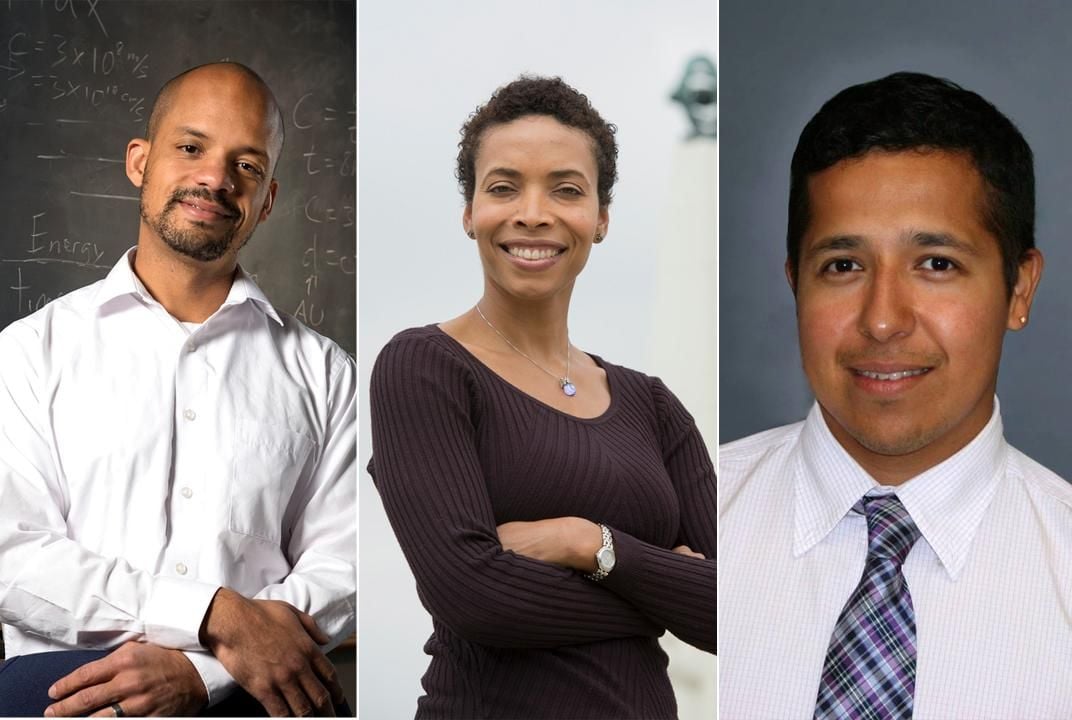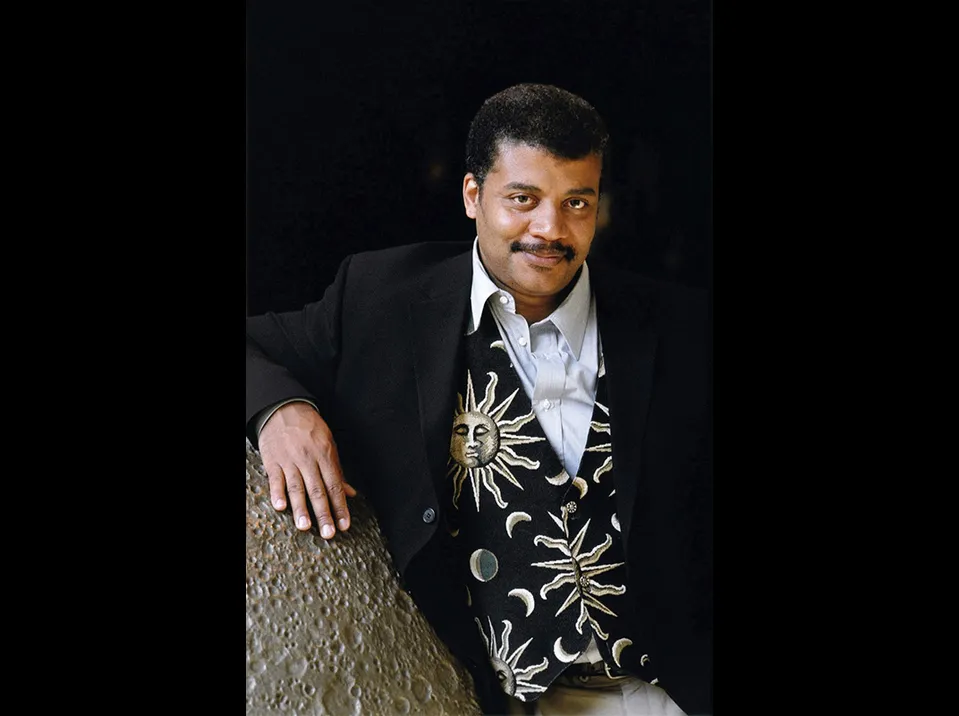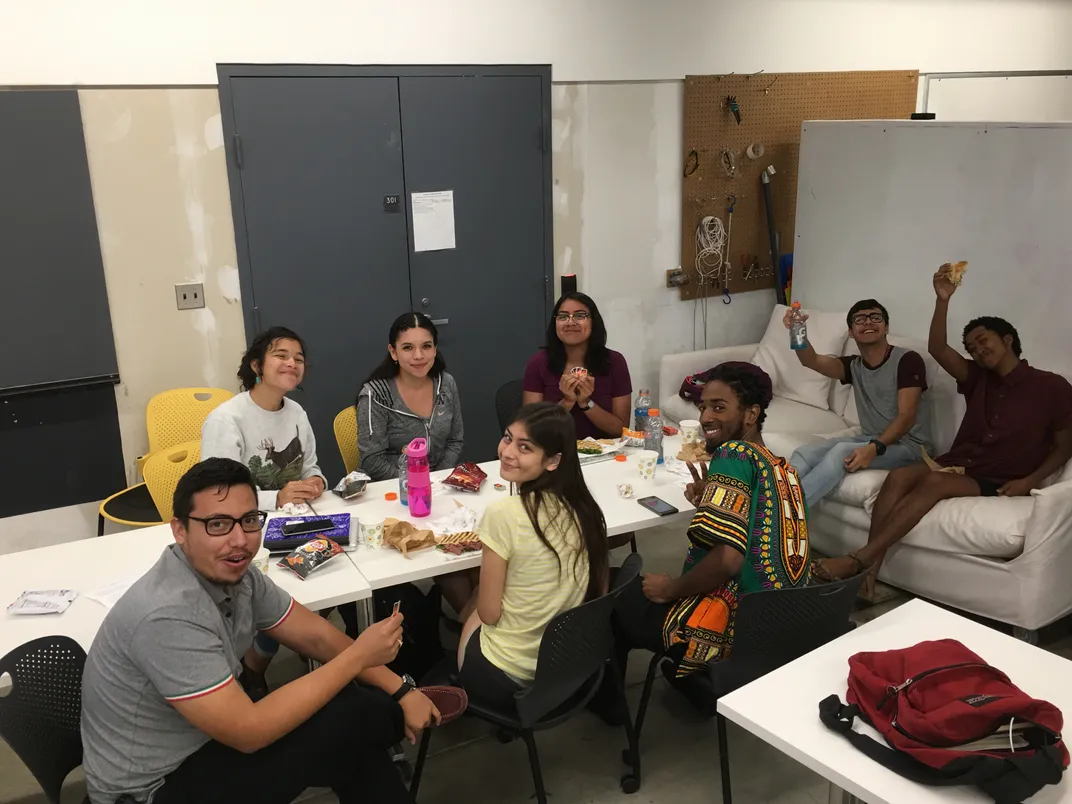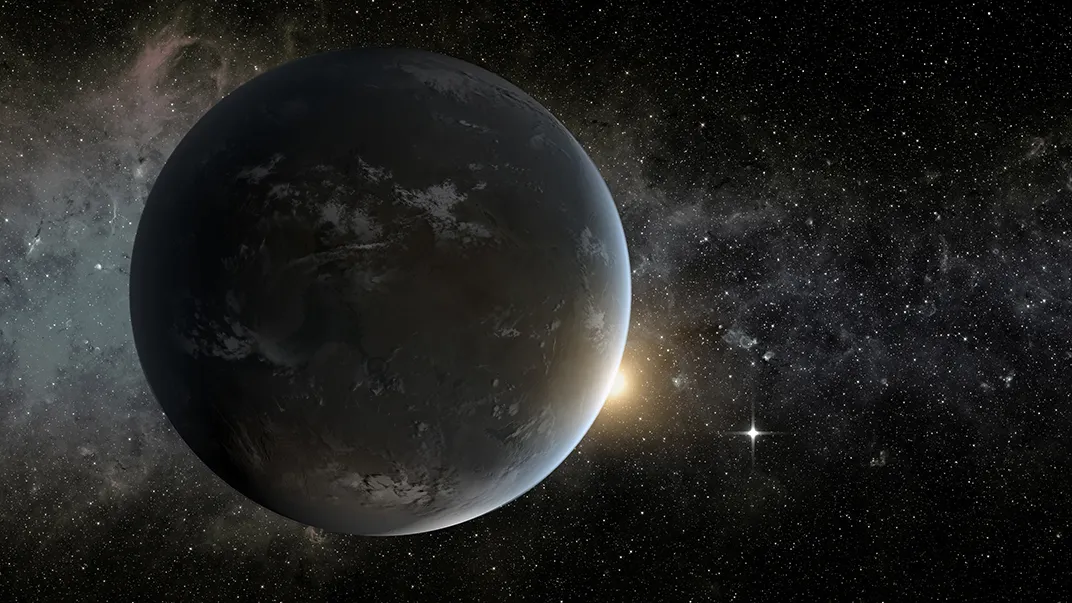Why the Universe Needs More Black and Latino Astronomers
Astronomy has one of the worst diversity rates of any scientific field. This Harvard program is trying to change that
/https://tf-cmsv2-smithsonianmag-media.s3.amazonaws.com/filer/09/cf/09cf7b6d-5b9e-4394-97f3-2b7b340326c5/banneker___aztlan_students.jpg)
Alton Sterling. Philando Castile. Pedro Villanueva. Anthony Nuñez.
These four names—all recent black and Latino victims of police violence—stare out at a college classroom full of budding astronomers. Written above them on the chalkboard is the now-familiar rallying call “Black Lives Matter.” It's a Friday morning in July, and John Johnson, a black astronomer at the Harvard-Smithsonian Center for Astrophysics, has written these words as part of the day’s agenda. Later this afternoon, they’ll serve as a launching point for a discussion about these specific killings and the implications of systemic racism.
It's something you might expect in an African American history class, or maybe a class on social justice. But this is a summer astronomy internship. Most astronomy internships are about parsing through tedious telescope data, battling with an arcane computer language in a basement, or making a poster to present at a conference: skills meant to help you get into grad school. The point of this class, which is made up entirely of African-American and Latino college students, is something very different.
The Banneker Institute is an ambitious new program meant to increase the number of black and Latino astronomers in the field—and to ensure that they are equipped to grapple with the social forces they will face in their careers. Undergraduates from all over the country apply to the Institute, which pays for them to live and work at Harvard for the summer. During the program, they alternate between specific research projects, general analysis techniques, and social justice activism—hence the names on the chalkboard.
Johnson, who studies extrasolar planets and is pioneering new ways to find them, started the program two years ago as a way to open up a historically rarefied, white, male enterprise. In 2013, Johnson left a professorship at Caltech to move to Harvard, citing Caltech’s lackluster commitment to diversity.
His own interest in the topic, he says, came out of the same basic curiosity that drives his research. “I’m really curious about how planets form,” says Johnson, whose research has helped astronomers revise their attitudes about planets around dwarf stars, which are now considered some of the best places to search for life. “The other thing I want to know the answer to is: Where are all the black folks? Because the further I went in my career, the fewer and fewer black people I saw.”
When he looked up the diversity statistics, Johnson became even more convinced: first that a problem existed, and then that something needed to be done about it. Not just for the sake of fairness, but for the advancement of the field.
The big questions at play in the study of astronomy—dark energy, dark matter, the search for life—require an all-hands-on-deck approach, says Johnson. “We have waiting in the wings a good 60 percent to 75 percent of our population in the form of white women, black and Latino and Native people that are ready to bring their cultural experiences to bear on solving the problems of the universe,” he says.
In Johnson’s mind, the right way to think about what greater diversity could do for astronomy is to recall what European Jews did for physics during the early 20th century, once they were allowed to enter the profession. “People were stuck on the problem of gravity and didn’t really know how to think about space-time,” Johnson says. “But this Jewish guy named Einstein rolls up on the scene, and he invents a whole new way of doing music. He did jazz.”

Given that America's most recognizable scientist is probably Neil DeGrasse Tyson, a black astronomer, it might come as a surprise to some that the field has a diversity problem. But that’s like pointing to President Barack Obama’s election as proof that America has become a post-racial society. Even Tyson, a peerless success story, openly discusses the obstacles he faced. Upon hearing that he wanted to be an astrophysicist, for instance, teachers asked him why he didn’t want to be an athlete instead.
“The fact that I wanted be a scientist and an astrophysicist was hands down the path of most resistance through the forces of society,” he recalled at a 2009 panel.
Astronomy doesn’t just struggle with diversity; it’s among the worst of all scientific fields. In its professional ranks, astronomers are 90 percent white, about 1 percent black, about 1 percent Latino and 0 percent Native American, according to data from the 2007 Nelson Diversity Survey. If you lump physics and astronomy together, as a 2012 survey did, you get only slightly better ratios: 80 percent white, 2 percent black, 3 percent Hispanic and 1 percent “other.” (The remaining 14 percent of astronomers, according to the survey, are of Asian descent.)
For comparison, those last three groups, vanishingly rare in departments devoted to unraveling what makes up the universe, comprise about one-third of all Americans. For women of color, the numbers are even more striking. In August, the organization African-American Women in Physics listed 132 black women who have achieved Ph.D.s in any of the disciplines of physics. Ever.
It's not that people of color don’t set out to study the universe, says Johnson. “Black kids are people,” he says, “and when they learn about planets orbiting other stars, they get just as excited, and their faces light up in the exact same way.”
Nor is the issue overt racism, at least not often. Instead, it’s the slow accumulation of discouragement and discomfort on the long trek to tenure, says Jorge Moreno, who researches interacting galaxies at Cal Poly Pomona. While it’s hard to separate out numbers for just physics and astronomy, around 65 percent of black and 49 percent of Hispanic undergraduates who set out to major in STEM fields end up dropping out or pursuing another major, according to the National Center for Education Statistics.

The problem is that black and Latino students see few peers and almost no mentors who look like them, says Moreno, who chairs the American Astronomical Society’s Committee on the Status of Minorities in Astronomy. “Deep down you feel like maybe I don’t belong here,” he says. One of Moreno’s most cited papers argues that pairs of galaxies don’t just influence one another, but are also shaped by the gravitational tugs of the rest of the universe; it is perhaps an apt metaphor for the experience of young astronomers of color, who find their careers shaped by both their immediate settings and by America's broader discourse on race.
Born and educated in Mexico, Moreno weathered some of those discouragements while he was a Ph.D. candidate at the University of Pennsylvania. His white, male classmates thought they were being welcoming. “I remember vividly people saying ‘oh, we don’t really see you as Hispanic, we see you as one of us.’ Which is basically saying my culture or my background is not valid, but hey, you are part of the club,” he says. “It bothered me for many years and I didn’t even know what was going on.”
Moreno stuck with astronomy. But many other students, when faced with these kinds of experiences, choose to enter a more supportive field. Cumulatively, promising students of color trickle out into other disciplines.
Johnson believes the solution is be to stop thinking about “diversity” as adding seasoning to predominantly white departments, and start thinking about assembling a critical mass. So last year, he started cornering students of color at conferences, and inviting them to work with him at Harvard. This year, Moreno joined him to run the program’s Latino arm, called the Aztlán Institute, and Harvard postdoc Nia Imara joined to advise research projects. University of California at Los Angeles astrophysicist Aomawa Shields pitched in with her research acumen and public speaking expertise.
Together, they alternate their classes with critical race theory with research training, having students watch documentary films like RACE: The Power of An Illusion and discuss the works of writers like James Baldwin and Michelle Alexander. Nineteen students showed up this year, hailing from historically black colleges, the Ivy League and other schools across the country. Amid other exercises, Johnson had them figure out why only stars with heavy elements should be expected to have Jupiter-mass planets. Then, on Sundays, he had them all over to his house to play spades.
Fittingly, the Institute is named for Benjamin Banneker, the self-taught surveyor who wrote the Farmer's Almanac series and arguably America's first African-American astronomer. Its logo depicts the North Star, in the geometric style of slavery-era quilts. Johnson hopes that when students leave the program, they'll be armed with a new awareness of race in America and a community of their peers, plus a toolkit for astronomical research. By the time they get to graduate school, the thinking goes, they’ll be so prepared that the hidden obstacles they face won’t deter them from entering the field.
Johnson knows that one summer program can't undo a long history of systemic exclusion. The subtle—or not so subtle—discouragements will still be waiting to trip some students up. “I can’t prevent it happening to them, but I can help them understand what’s happening, and that helps them take agency over their experience,” he says. With this program, he's trying to at least make sure his students won't face those challenges alone and unprepared.
“Nobody who loves studying the universe should be left to that fate,” he says. “It’s wrong.”

The Harvard program, with its explicit focus on social justice, comes at a fraught time for astronomy. Last fall, Buzzfeed’s Azeen Ghorayshi reported that famed exoplanet astronomer Geoff Marcy of the University of California at Berkeley had been sexually harassing female students for years—even as institutional structures shielded him from repercussions. (Berkeley’s chancellor, Nicholas Dirks, just announced he will step down in the wake of the scandal.)
While awful, these kinds of high-profile stories may at least bring an awareness of the issues women face in astronomy. Since a 1992 conference on women in astronomy in Baltimore, a sustained women’s movement has increased representation within the field. Yet as the Marcy story illustrates, there is still much work to be done. Moreover, Johnson and others argue that what progress has been made thus far has largely served to include white women and not women of color.
Recently, frank discussions about these issues empowered by Twitter, blogs, Facebook groups, and conference sessions have meant that in many cases, racial disparities are no longer being swept under the rug.
For instance, in Hawaii, some native Hawaiians are fighting the construction of a massive new telescope atop a sacred mountain. When a senior astronomer referred to those protesters as “a horde of Native Hawaiians who are lying,” other astronomers, including Johnson, fired back—forcing an apology and shaping future coverage of the contentious issue. Likewise, when remarks from Supreme Court justices John Roberts and Antonin Scalia questioned the value of black physics students during a key affirmative action trial in 2015, over 2,000 physicists used Google documents to sign a letter arguing the contrary.
“Maybe we’re beginning to recognize the ways in which we have been doing harm,” says Keivan Stassun, an astronomer at Vanderbilt University. “It’s a question of stopping the harm.”
Stassun has spent the last 12 years leading an effort with parallel goals to the one at Harvard. The Fisk-Vanderbilt Bridge Program identifies promising students from historically black colleges, and seeks to admit them into Vanderbilt’s doctoral program. In evaluating talent, the program ignores the Graduate Record Exam or GRE, a supposedly meritocratic measure that is used by most graduate schools (and most astronomy departments), and tends to correlate with race and gender (on the quantitative part of the test, women score an average of 80 points below men and African-Americans 200 points below white test takers).
The program has had stunning results: “We’re now producing somewhere between a half and two-thirds of the African-American PhDs in astronomy,” says Stassun, who has Mexican and Iranian heritage.
It’s no surprise, then, that when a group of astronomers of color planned the first-ever Inclusive Astronomy Conference in June 2015, they chose Vanderbilt to host. The conference promoted inclusivity in the broadest sense, encompassing race, class, gender and sexuality, disability and any intersections thereof. It concluded by making a series of recommendations, which were ultimately endorsed by the American Astronomical Society (AAS), along with Stassun’s suggestion to drop the GRE cutoff.
It should have been a triumphant moment for astronomers of color. But on June 17, the first night of the conference, national news outlets reported that a white man had opened fire in a historically black church in Charleston, South Carolina. The racially-motivated mass shooting killed nine African-Americans. Chanda Prescod-Weinstein, a University of Washington theorist and prominent activist at the conference, felt that the tragedy offered white astronomers ample opportunity to see their black colleagues' grief—and to express their solidarity.
Yet the AAS remained silent. Prescod-Weinstein says she was surprised and disheartened, given that the organization had spoken out on issues like Marcy’s sexual harassment, sexism and the teaching of creationism in public schools, and eventually approved many other aspects of the inclusivity conference. (A spokesperson for the AAS said that the organization "issues statements only on matters directly related to astronomy in some way.")
As Prescod-Weinstein wrote in an email: “What does it mean for AAS to adopt the recommendations, while still finding itself unable to officially utter the words ‘Black lives matter’?”

Back in the classroom at Harvard, everyone’s focus is Aomawa Shields, the UCLA astrophysicist, who is teaching today’s class.
Since 2014, Shields has been modeling the atmospheres of planets around other stars. Recently, she made waves by showing that Kepler 62f, one of the most tantalizing planets found by NASA’s Kepler telescope, could have liquid water—and thus, maybe, life—on its surface. Before her science Ph.D., she got an MFA in theatre. Today, she's using both degrees to explain a public speaking exercise meant to help students reconcile their dual identities as scientists and as human beings in a world impacted by race and other socioeconomic forces.
Following her instructions, the undergraduate astronomy students split into pairs. First they share a story from their personal lives. After two minutes, an iPhone timer goes off, and they switch to technical descriptions of their research, trading college crushes for histograms. When the timer goes off again, they switch back, inducing the whiplash of being a Person and Scientist at the same time—an experience that all scientists grapple with, but that students from underrepresented minorities often find particularly poignant.
After the students have completed the exercise, Shields asks: “Why do you think I had you do that activity?” From across the room, the responses start coming in.
“I feel like I was talking from my brain, and then from my heart.”
“For me it helped connect life and research.”
Then one student describes her trouble coming up with the right analogy to explain a technical process. She's writing computer code to search in the disk of debris around a star, combing for disturbances that would tip off the location of a hidden planet. In other circumstances, Hope Pegues, a rising senior at North Carolina Agricultural and Technical State University, might not speak up. But in this environment, she feels comfortable enough among her peers to make a suggestion.
“Maybe it’s like looking at the back of a CD, to find where it’s skipping,” she says.
Her peers snap their fingers, and she soaks in their approval. “I can go for days,” she says.
/https://tf-cmsv2-smithsonianmag-media.s3.amazonaws.com/accounts/headshot/SOKOL11.jpg)
/https://tf-cmsv2-smithsonianmag-media.s3.amazonaws.com/accounts/headshot/SOKOL11.jpg)